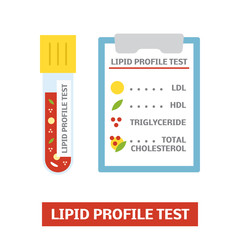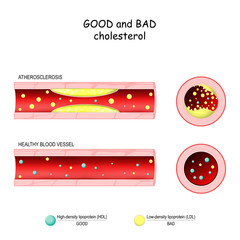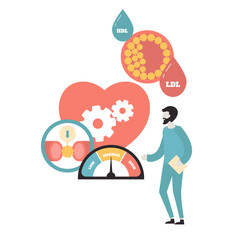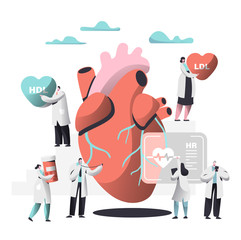Lipid Profile Test – Definition, Procedure, Normal Range And More
What Is Lipid Profile Test?
A lipid panel or lipid profile test assesses the risk for cardiovascular disease in a person. It is a combination of various blood tests, which is performed to measure the levels of 4 types of lipids in our blood such as
- Total cholesterol
- Low-density lipoprotein cholesterol (LDL cholesterol)
- High-density lipoprotein cholesterol (HDL cholesterol)
- Triglycerides
What Are Lipids?
Lipid is a fat or fat-like substance which is essential for the proper functioning of our body. It is a source of energy for our body, normally stored both in our blood and tissues. However, too much lipid leads to diseases that are even life-threatening, for instance, coronary artery disease, stroke or heart attack. Both triglycerides and cholesterol are lipids.
Why Get Tested?

A lipid profile test is required to identify the symptoms associated with dyslipidemia or abnormal levels of lipid.
Some of the symptoms of dyslipidemia are-
- Upper back pain
- Hypertension
- General malaise(feeling of discomfort)
- Chest pain and squeezing sensation in the chest
- Shortness of breath
- Heartburn
- Arm pain
- Nausea and general epigastric discomfort
The test is also performed to evaluate the success of a treatment, for a diet control programme or check the effectiveness of drug therapy. The test results are helpful in diagnosis, monitoring as well as prevention of numerous medical conditions.
Even adults who don’t have the slightest risk factor, need to undergo a lipid profile test, every four years. But suppose if there are risk factors, then you have to frequently take the test. Among various types of lipids, elevated levels of LDL cholesterol is a major risk factor that leads to several medical conditions.
Some of the other risk factors are-
- Hypertension
- Smoking
- Family history of heart diseases
- Diabetes
- Obesity
- Heart attack
- Physical inactivity
- If you’re a male of 45 years or more
- If you’re a female of 50 years or more

Lipid Profile Test Procedure
The doctor may ask you to fast before undergoing a lipid profile test. The samples are taken after 12-14 hours of overnight fasting so that the results will be more accurate. You can drink clear fluids such as water, but you should avoid drinking beverages such as coffee and tea.
Before the lipid profile test, you need to take certain precautions. You need to-
- Avoid drinking alcohol
- Avoid high-fat food
- Avoid strenuous exercise
Most probably, your blood will be drawn in the morning, after lipid profile fasting. Your blood sample is taken by inserting a needle into your vein. In other cases, the blood sample will be taken by pricking your fingertip. The blood is collected in a vial. Upon collection of your blood sample, it will be analysed in the laboratory, where the level of triglycerides, HDL cholesterol and LDL cholesterol are measured. The procedure lasts only for a few minutes. There are no risks associated with lipid profile test.
Sometimes, you can undergo the test without fasting. Fasting isn’t required, for children, teenagers and adults up to age 24.
Normal Cholesterol Level
The level of cholesterol in our blood is normally measured in milligrams per deciliter (mg/dL). Lipid profile normal range is-
- Total cholesterol normal range- lower than 200mg/dL
- LDL cholesterol range- between 70 to 130mg/dL
- HDL cholesterol range- between 40 to 60mg/dL
- Triglycerides- between 10 to 150 mg/dL
These are lipid profile normal values.
Lipid Profile Test Cost
The average lipid profile test price is around Rs 400. The lipid profile test is very affordable. A lipid panel is normally used to determine the treatment if you have high risk, intermediate risk or borderline risk.

Understanding The Results Of Lipid Profile
The blood cholesterol level is normally measured in milligrams per deciliter (mg/dL). Your lipid profile test results will be in mg/dL. Your doctor can predict the risk of cardiovascular diseases by considering various factors such as HDL, total cholesterol etc. Other risk factors are also taken into consideration, such as high blood pressure, family history, etc.
Suppose if your lipid profile test results or cholesterol test results are outside the normal range of cholesterol, then you have more risk of heart diseases, strokes and other conditions. In case of abnormal cholesterol levels, you need to take other tests such as thyroid test or blood glucose test. A thyroid test is done to check whether you have an underactive thyroid. A blood glucose test is done to check for diabetes.
LDL Cholesterol
LDL normal range is between 70 to 130mg/dL. LDL cholesterol is known as bad cholesterol. Therefore lower levels of LDL is essential for your heart health. LDL cholesterol can accumulate in the artery walls with time, which leads to many heart diseases. If your LDL level is more than 190, then it’s regarded as very high. Therefore, you will be asked to take statins, a medicine that considerably reduces the level of LDL.
HDL Cholesterol
HDL cholesterol normal range is between 40 to 60mg/dL.
You’re at high risk if you have lower levels of HDL cholesterol.
For men- lower than 40mg/dL indicates high risk.
For women- lower than 50mg/dL indicates high risk.
HDL cholesterol is referred to as good cholesterol. You have a low risk if the HDL level is higher. This is because HDL protects you from heart diseases by preventing the accumulation of bad cholesterol in your artery walls. A combination of statin drug and proper exercise can improve the level of HDL cholesterol in your blood.
Triglycerides
The normal range of triglycerides is between 10 to 150mg/dL.
- Between 150 to 199mg/dL- borderline high-risk
- Between 200 to 499mg/dL- high-risk
- 500 mg/dL- very high-risk
If your triglycerides test results indicate a higher level of triglycerides, then you have a risk of coronary artery disease. People who have diabetes or heart disease also have higher levels of triglycerides. Other reasons for elevated levels of triglycerides include genetic disorders and underlying diseases.
If you’ve high levels of triglycerides, then the levels of LDL cholesterol and total cholesterol will also be high.
Total Cholesterol
- Less than 200mg/dL- Normal level
- Between 200 to 239 mg/dL- Borderline high-risk
- More than 240 mg/dL- High-risk
Total cholesterol score is calculated by adding 20% of triglyceride level, level of LDL cholesterol and level of HDL cholesterol.
Besides reviewing your lipid profile test results, your doctor will also take into consideration various risk factors such as your age, gender, family history, diet, weight and much more.

It is highly recommended to take a lipid profile test, as early as age 20. If you have stroke, diabetes, heart disease and if you’re taking cholesterol-lowering medications, then you need to take a lipid profile test every year. Children between the age of 9 and 11 as well as between age 17 and 21 need to take a lipid profile test.
Suppose if a child has a family history of diabetes, coronary artery disease or even obesity, then he/she has to undergo frequent lipid profile tests.
After all, you can manage a higher level of cholesterol. Your doctor may create a treatment plan for you after the lipid profile test. You have to take cholesterol-lowering medications as well as change your diet, and do regular exercise. You can reduce the risk of stroke or heart disease if you have healthy lipid levels. If you make more lifestyle changes, you can have better results.